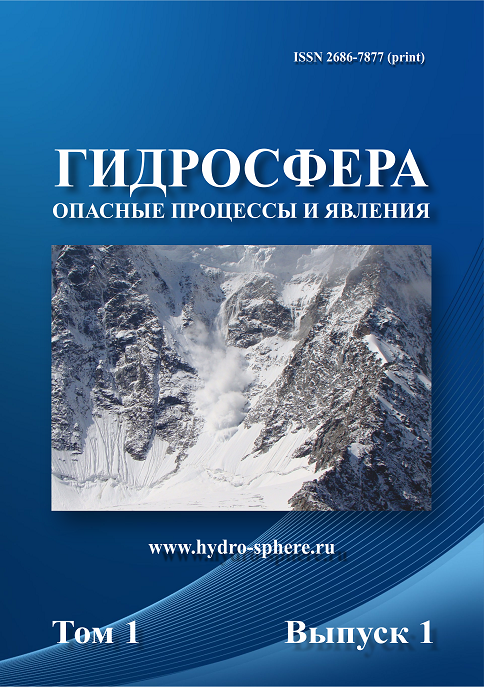ОЦЕНКА ДИНАМИЧЕСКИХ ХАРАКТЕРИСТИК СЕЛЕВОГО ПОТОКА ПО ВИДЕОМАТЕРИАЛАМ
Авторы
- Д.П. Соколова ООО «Джи Динамика», г. Санкт-Петербург, Россия
- В.А. Куровская Московский государственный университет им. М.В. Ломоносова, г. Москва, Россия https://orcid.org/0000-0002-2633-3634
- А.А. Осташов Специальное конструкторское бюро средств автоматизации морских исследований ДВО РАН, г. Южно-Сахалинск, Россия
- Н.А. Казаков Специальное конструкторское бюро средств автоматизации морских исследований ДВО РАН, г. Южно-Сахалинск, Россия; Научно-исследовательский центр "Геодинамика", г. Южно-Сахалинск, Россия https://orcid.org/0000-0002-4400-7250
DOI:
https://doi.org/10.34753/HS.2019.1.1.003+ Ключевые слова
+ Аннотация
Для проектирования сооружений противоселевой защиты необходимо знать значения таких характеристик селя, как скорость потока и давление селевой массы на преграду. Определение этих характеристик часто вызывает трудности из-за того, что сель – достаточно редкое событие и постоянные наблюдения за ними ведутся на селестоковых станциях, которых во всем мире немного. В настоящее время в интернете появилось большое количество видеосъемок, на которых запечатлен сход селевого потока. Такой материал можно использовать для получения не только качественных, но и количественных характеристик селевого потока. В тех случаях, когда имеется возможность определить на видео масштаб и конкретное место схода селя, определение его скорости и других характеристик составляет выполнимую задачу. В статье представлена попытка количественной оценки скорости селевого потока по материалам видеосъемки с последующим сравнением полученных результатов со значениями, рассчитанными по различным методикам. В качестве объекта нашего исследования был выбран селевой поток, сошедший в Австрии, г. Фирген 4 августа 2012 года. Съемка производилась с нескольких ракурсов, что позволило выбрать участок канала, на котором оказалось возможным произвести измерение скорости движения серии селевых волн. Расчет скорости селевого потока и давления на препятствие производился по методикам разных исследователей. Измеренные на видеоролике скорости селевых волн на разных участках составили: минимальная – 7,4 м/с, максимальная – 10 м/с. Различия между рассчитанными по разным методикам и измеренными по видео значениями составляют от 0,1 м/с до 4,8 м/с. Кроме этого, были проведены расчеты расхода селевого потока и плотности селевой массы. Нами использовалась модель транспортно-сдвигового селевого процесса, разработанная Ю.Б. Виноградовым. При сравнении полученных значений с результатами австрийских коллег было выявлено, что значения характеристик похожи, но разброс значений по данной модели меньше. Литература Виноградов Ю.Б. Этюды о селевых потоках. Л.: Гидрометеоиздат, 1980. 144 с. Голубцов В.В. О гидравлическом сопротивлении и формуле для расчета средней скорости течения горных рек // Труды КазНИГМИ. 1969. Вып. 33. С. 30-41. Гонор А.Л., Пик-Пичак Е.Г. Численное моделирование удара снежной лавины по твердой стенке // Известия Академии наук СССР. Механика жидкости и газа. 1983. № 6. С. 86–91. Казаков Н.А. Волновая динамика селей // Геоэкология. Инженерная геология. Гидрогеология. Геокриология. 2001. № 2. С. 158-164. Молжигитов С.К. Оценка ударной нагрузки селевого потока на поперечную жесткую преграду // Международный журнал прикладных и фундаментальных исследований. 2016. № 3 (часть 1). С. 16-20. Срибный М.Ф. Формула средней скорости течения рек и их гидравлическая классификация по сопротивлению движению // Исследования и комплексное использование водных ресурсов. М.: Изд-во АН СССР, 1960. С. 204-220. Aulitzky Н. The debris flows of Austria // Bulletin of the International Association of Engineering Geology (Bulletin de l'Association Internationale de Géologie de l'Ingénieur). 1989. Volume 40. Issue 1. P. 5–13. DOI: 10.1007/BF02590338 Hübl J. Ereignisdokumentation, Band 3: Jahresrückblick der Ereignisse. IAN Report 150. Wien, Februar 2013, 88 p. Виноградова Т.А., Виноградов А.Ю. Экспериментальные селевые потоки в бассейне р. Чемолган // Природные опасности. 2017. Том. 88. Доп. 1. пп. 189-198.
DOI: 10.1007 / s11069-017-2853-z
+ Биографии авторов
E-mail: dariia.sokolova@yandex.ru E-mail: viktoriiakurovskaia@gmail.com E-mail: andrey.ostashov@gmail.com E-mail: cdsmd@yandex.ru
Д.П. Соколова, ООО «Джи Динамика», г. Санкт-Петербург, Россия
eLibrary (РИНЦ) SPIN-код: 8810-5636
Scopus ID:
Почтовый адрес: 693000 г. Южно-Сахалинск, ул. Ленина, 246 - 11
Контактный телефон: +7-4242-75-20-61
В.А. Куровская, Московский государственный университет им. М.В. Ломоносова, г. Москва, Россия
eLibrary (РИНЦ) SPIN-код: 5059-8670
ORCID ID: 0000-0002-2633-3634
Scopus ID:
Почтовый адрес: 693000 г. Южно-Сахалинск, ул. Ленина, 246 - 11
Контактный телефон: +7-4242-75-20-61
А.А. Осташов, Специальное конструкторское бюро средств автоматизации морских исследований ДВО РАН, г. Южно-Сахалинск, Россия
eLibrary (РИНЦ) SPIN-код: 8844-3466
ORCID ID: 0000-0001-5826-4138
Scopus ID:
Почтовый адрес: 693000 г. Южно-Сахалинск, ул. Ленина, 246 - 11
Контактный телефон: +7-4242-75-20-61
Н.А. Казаков, Специальное конструкторское бюро средств автоматизации морских исследований ДВО РАН, г. Южно-Сахалинск, Россия; Научно-исследовательский центр "Геодинамика", г. Южно-Сахалинск, Россия
eLibrary (РИНЦ) SPIN-код: 3869-6750
Scopus ID: 55771991700
Почтовый адрес: 693000 г. Южно-Сахалинск, ул. Ленина, 246 - 11
Контактный телефон: 8-4242-75-20-61
+ Библиографические ссылки
Aulitzky Н. The debris flows of Austria. Bulletin of the International Association of Engineering Geology (Bulle-tin de l'Association Internationale de Géologie de l'Ingé-nieur), 1989, vol. 40, iss. 1, pp. 5-13. DOI: 10.1007/BF02590338 Golubtsov V.V. O gidravlicheskom soprotivlenii i for-mule dlya rascheta srednei skorosti techeniya gornykh rek [About the hydraulic resistance and a formula for calcula-tion of average speed of a current of the mountain rivers]. Trudy Kazakhskogo regional'nogo nauchno-issledovatel'skogo gidrometeorologicheskogo instituta [Transactions of the Kazakh Regional Hydrometeorologi-cal Research Institute], 1969, no. 33, pp. 30-41. (in Russian). Gonor A.L., Pik-Pichak E.G. Chislennoe modelirovanie udara snezhnoi laviny po tverdoi stenke [Numerical mod-eling of snow avalanche impact on a solid wall]. Izvestiya Akademii nauk SSSR. Mekhanika zhidkosti i gaza [News of the USSR Academy of Sciences. Mechanics of fluid and gas], 1983, no. 6, pp. 86–91. (in Russian). Hübl J. Event documentation, Volume 3: Annual review of events. IAN Report 150. Vienna, February 2013, 88 p. (in German). Kazakov N.A. Volnovaya dinamika selei [Wave dynam-ics of debris flows]. Geoekologiya. Inzhenernaya geologi-ya. Gidrogeologiya. Geokriologiya. [Geoecology. Engi-neering geology. Hydrogeology. Geocryology], 2001, no 2, pp. 158-164. (in Russian). Molzhigitov S.K. Otsenka udarnoi nagruzki selevogo potoka na poperechnuyu zhestkuyu pregradu [Estimation of the impact load of the mudflow on the transverse rigid barrier] Mezhdunarodnyi zhurnal prikladnykh i fundamen-tal'nykh issledovanii [International journal of applied and fundamental research], 2016, no. 3 (part 1), pp. 16-20. (in Russian; abstract in English). Sribnyi M.F. Formula srednei skorosti techeniya rek i ikh gidravlicheskaya klassifikatsiya po soprotivleniyu dvizheniyu [Formula of the average flow velocity of riv-ers and their hydraulic classification by resistance to the movement] Issledovaniya i kompleksnoe ispol'zovanie vodnykh resursov [Researches and complex use of water resources]. Moscow: Publishing house of the USSR Academy of Science, 1960, pp. 204-220. (in Russian). Vinogradov Yu.B. Etyudy o selevykh potokakh [Etudes about mud stream]. Leningrad, Gidrometeoizdat Publ., 1980. 144 p. (in Russian). Vinogradova T.A., Vinogradov A.Y., 2017. The experi-mental debris flows in the Chemolgan river basin. Natural Hazards, Vol. 88, No. 1, pp. 189-198. DOI: 10.1007/s11069-017-2853-z














1.png)














